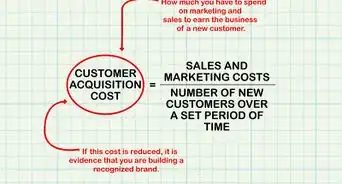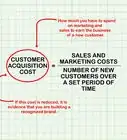This article was co-authored by Michael R. Lewis. Michael R. Lewis is a retired corporate executive, entrepreneur, and investment advisor in Texas. He has over 40 years of experience in business and finance, including as a Vice President for Blue Cross Blue Shield of Texas. He has a BBA in Industrial Management from the University of Texas at Austin.
There are 10 references cited in this article, which can be found at the bottom of the page.
wikiHow marks an article as reader-approved once it receives enough positive feedback. In this case, 93% of readers who voted found the article helpful, earning it our reader-approved status.
This article has been viewed 153,264 times.
One way that businesses remain competitive is by improving their processes, both operational and financial. Doing so requires the creation of a way to specifically measure improvement. As the saying goes, "what can't be measured can't be managed." To solve this issue, businesses create metrics, measurable details of a process, to gather data about a process before and after a change is introduced. Analyzing these metrics provides data that communicates how much the change improved the process, if at all. To get started, it's important to first choose the most appropriate metrics for your process.
Steps
Organizing Your Process Improvement System
-
1Define what needs to be measured. That is, define what exactly you mean by improvement. Do you want your process to more reliable, faster, more efficient, or better in some other way? This brings clarity to the project. Be sure that your process produces an output that can be measured in some way.[1]
- For example, a company wanting to improve delivery speed would measure time. A data digitizing company might measure percentage of character errors in batches, or process output.
-
2Make your project vocabulary consistent. Be sure to use commonly understood definitions to ensure consistency and accuracy. This guarantees reliability of information that is shared among people from different facilities or locations. Prevent misunderstandings by providing clear definitions of all variables being measured.
- For example, suppose a company is measuring time in days. Different branches of the same company may define “one day” in different ways. It could mean business days only, any 24 hour period, or the 8-hour work day. These kinds of inconsistencies can be misleading.[2]
Advertisement -
3Define how data is to be collected. Data must be collected in a similar fashion across the company. For example, if one department uses random sampling to collect data, so must all of the others. Otherwise it will be impossible to compare their data. Also, units of measure must be defined. Be sure that units of measure are equal wherever your output is measured.
- For example, delivery speed could be measured either in minutes or hours, and taking time to convert one to the other would be inefficient.
-
4Standardize precision of calculations. This just means that you shouldn't have one department rounding off time to the hour and another specifying time in hours and hundredths of an hour. Otherwise, different levels of detail in the values will confuse the results. Keep in mind that smaller units tend to give more accurate results.
- For example, all departments must agree how to round off decimals.
Choosing the Right Metrics for Your Project
-
1Choose a primary metric. The primary metric defines the output or goal of the process improvement. For example, an automobile factory might choose number of cars produced per hour. Before a process improvement is introduced, a baseline measurement is taken. At the end of the project, the process is measured again. The amount of improvement is then calculated.[3]
-
2Connect your primary metric to a business metric. The business metric measures how an operational improvement achieves one of the company's goals. For example, if the primary metric is to manufacture the product faster, the business metric might be increased profit or reduced fixed costs. There is a cause-and-effect relationship between the primary and the business metrics. It demonstrates why the improvement in the primary metric is good for business.[4]
-
3Consider the possibility of unforeseen outcomes. There may be collateral damage caused by the process improvement project. If the primary metric measures what must be improved, there must be another metric, the consequential metric, to measure what must not change. Consequential metric data should be collected before, during and after the project. Of the many possible consequential metrics in a given project, only the top few which impact the quality of outputs should be considered.[5]
- For example, a company trying to improve delivery speed should not see an increase in damaged products due to sloppy handling. Proportion of damaged products would be the consequential metric in this case.
-
4Establish a financial metric. Saving money may not be a company’s primary metric. However, companies need to monitor the financial results of improvement processes. This should not be confused with an accounting of the cost of the project. Rather, the financial metric should be a tool for analyzing the financial benefit of the project. Many companies continue to monitor the financial metric for up to one year after the completion of the project.[6]
- For example, an improvement in manufacturing time may be expected to increase the company's revenues. The company would monitor revenue, along with other factors like profit, from the time the changes were instituted and on to measure how the change in process affected them.
Collecting the Data
-
1Measure time. Process time measures how long it takes to complete the steps of creating a product or service. Other time metrics measure time spent adding value to a project, or how long it takes to respond to a customer’s request. Metric calculations may include the percent on time delivery.[7]
- Reducing process time is a proven strategy for better business. Doing so allows for greater production and delivers the product or service sooner. Consider furniture manufacturing. All things being equal, customers would rather receive their new couch or dining room set sooner rather than later. If you can reduce process time, you improve your chances for repeat orders and new business.
-
2Measure costs. Cost metrics assess the total cost of the production process. They also measure operational costs relative to production levels. Cost per transaction measures the cost to produce one unit. Cost savings measures reduction in costs per transaction. Labor savings measures a reduction in labor hours needed to produce the product or service.[8]
- Cost reduction strategies become important to businesses when revenue starts to decline. For example, when Bank of America experienced a downturn in lending and trading revenue in 2011, they decided to reduce their workforce in order to continue delivering revenues to shareholders. Bank managers and consultants decided to use cost metrics to identify jobs to eliminate that could save the most money without compromising the organization.[9]
-
3Measure quality. Quality metrics measure customer satisfaction. Customer satisfaction data can be gathered from surveys, registered complaints and other feedback. Quality metrics also assess whether the process creates value for the customer. They also look at the frequency of errors and the need for reworks. The defect rate looks at the percentage of mistakes. The percent complete and accurate rate measures how often no mistakes are made.[10]
- The healthcare industry relies heavily on quality metrics. Quality improvement must be data-driven. Analysts look at financial and clinical data to identify variations in how health care is delivered by providers. They break down the process and find areas of waste or redundancy in order to create a process that delivers a high-quality clinical outcome. The cost reduction is not valuable unless it increases or maintains the current level of quality provided.[11]
- The key in quality improvement is to increase efficiency without compromising effectiveness. Efficiency refers to the amount of resources necessary to deliver a product or service. Effectiveness refers to how well the objectives of the product or service have been achieved.[12]
-
4Measure output. Output metrics measure the quantity of products or services produced in a given time period. The production goal should align with customer demand. Output metrics also look at backlogs and excess inventory. These should be minimal. Finally, works in progress is measured. This determines the number of products or services in the pipeline.[13]
- One strategy for increasing output in manufacturing is standardized work. For example, in the automobile industry, auto makers have a standard method for assembling cars. Manufacturers can standardize production processes with the goal of increasing output. Metrics can help to analyze how well a process improves the output for the manufacturer. If more products are produced in a given time with the new standardized process, then it is a success.[14]
-
5Measure process complexity. This metric measures how many steps are in the production process. It also looks at how often the process is slowed by changing hands or requiring supervisory approval. The total number of process steps is calculated, along with the number of value-added process steps. These are the steps that make the product or service more valuable. Loop backs, or the number of times a product is sent back to correct errors, is also measured.[15]
- Companies aim to reduce the complexity in their processes, organization, products and information systems in order to stimulate growth, reduce costs and increase returns. Measuring process complexity helps managers to identify where products or services fully meet customer needs at the lowest cost. It helps to reveal hidden costs in overly complicated processes. It allows companies to identify which products are most profitable, what customers really value and where process bottlenecks are getting in the way of efficiency.[16]
References
- ↑ https://www.isixsigma.com/new-to-six-sigma/selecting-appropriate-metrics/
- ↑ http://www.managementstudyguide.com/need-for-operational-definition-of-metrics.htm
- ↑ https://www.isixsigma.com/operations/finance/be-consistent-six-sigma-project-metric-selection/
- ↑ https://www.isixsigma.com/operations/finance/be-consistent-six-sigma-project-metric-selection/
- ↑ https://www.isixsigma.com/operations/finance/be-consistent-six-sigma-project-metric-selection/
- ↑ https://www.isixsigma.com/operations/finance/be-consistent-six-sigma-project-metric-selection/
- ↑ http://www.isixsigma.com/methodology/metrics/
- ↑ http://www.isixsigma.com/methodology/metrics/
- ↑ https://hbr.org/2011/09/achieving-sustained-cost-reduc
- ↑ http://www.isixsigma.com/methodology/metrics/
- ↑ https://www.healthcatalyst.com/5-Deming-Principles-For-Healthcare-Process-Improvement
- ↑ http://www.bsmreview.com/oppseff.shtml
- ↑ http://www.isixsigma.com/methodology/metrics/
- ↑ http://www.cio.com/article/2398706/careers-staffing/improve-your-productivity-with-3-lean-manufacturing-principles.html
- ↑ http://www.isixsigma.com/methodology/metrics/
- ↑ http://www.bain.com/publications/articles/management-tools-complexity-reduction.aspx
About This Article
Measuring your business’s process improvement is crucial to its overall performance. You can measure your business’s processes using a variety of metrics, depending on your business set up. You can measure the time it takes to complete different steps of the design, manufacturing, or distribution process, or the total cost of the production process. Alternatively, measure customer satisfaction by using surveys, registered complaints, and other forms of feedback. You can also measure the quantity of your products or services produced in a given time period. Make sure you’re consistent with how data is gathered across your company and the units they measure it in to help you track your progress over time. For more tips from our Financial co-author, including how to account for unforeseen outcomes, read on!





































































